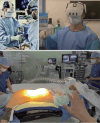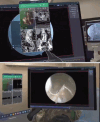The Utilization of Navigation and Emerging Technologies With Endoscopic Spine Surgery: A Narrative Review
- PMID: 40211520
- PMCID: PMC12010863
- DOI: 10.14245/ns.2449404.702
The Utilization of Navigation and Emerging Technologies With Endoscopic Spine Surgery: A Narrative Review
Abstract
Endoscopic spine surgery (ESS) is growing in popularity worldwide. An expanding body of literature demonstrates rapid functional recovery with reduced morbidity compared to open techniques. Both full endoscopic spine surgery, or uniportal endoscopy, and unilateral biportal endoscopy (UBE) can be employed in conjunction with various navigation and enabling technologies for assistance with localization of anatomic orientation and assessment of the intraoperative target spinal pathology. This review article describes various navigation technologies in ESS, including 2-dimensional (2D) fluoroscopic imaging, 2D fluoroscopic navigation, 3-dimensional C-arm navigation, augmented reality, and spinal robotics. Employment of enabling navigation and emerging technology with the registration of patient-specific anatomy enables clear delineation of anatomic landmarks and facilitation of a successful procedure. Additionally, avoidance of common pitfalls during use of navigation systems in ESS is discussed in this review.
Keywords: Enabling technology; Endoscopic spine surgery; Full endoscopic spine surgery; Navigation; Unilateral biportal endoscopy.
Conflict of interest statement
Sang Lee, MD PhD, Samuel Cho, MD, Jin-Sung Kim, MD PhD, and Don Young Park, MD report conflicts of interest. Conflict of interest forms are attached as supplementary materials. The author authors have nothing to disclose.
Figures







Similar articles
-
Minimally invasive endoscopy in spine surgery: where are we now?Eur Spine J. 2023 Aug;32(8):2755-2768. doi: 10.1007/s00586-023-07622-7. Epub 2023 Mar 1. Eur Spine J. 2023. PMID: 36856868 Review.
-
Unilateral Biportal Endoscopy for Lumbar Spinal Stenosis and Lumbar Disc Herniation.JBJS Essent Surg Tech. 2023 Jun 27;13(2):e22.00020. doi: 10.2106/JBJS.ST.22.00020. eCollection 2023 Apr-Jun. JBJS Essent Surg Tech. 2023. PMID: 38274147 Free PMC article.
-
Full Endoscopic Spine Surgery with Image-Guided Navigation System as "Hybrid Endoscopic Spine Surgery": A Narrative Review.World Neurosurg. 2023 Nov;179:45-48. doi: 10.1016/j.wneu.2023.07.135. Epub 2023 Aug 4. World Neurosurg. 2023. PMID: 37543200 Review.
-
Applications of navigation in full-endoscopic spine surgery.Eur Spine J. 2024 Feb;33(2):429-437. doi: 10.1007/s00586-023-07918-8. Epub 2023 Sep 29. Eur Spine J. 2024. PMID: 37773448
-
Image-guided endoscopic spine surgery: Part I. A feasibility study.Spine (Phila Pa 1976). 2001 Aug 1;26(15):1705-10. doi: 10.1097/00007632-200108010-00015. Spine (Phila Pa 1976). 2001. PMID: 11474358
References
-
- Simpson AK, Lightsey HM, Xiong GX, et al. Spinal endoscopy: evidence, techniques, global trends, and future projections. Spine J. 2022;22:64–74. - PubMed
-
- Ohara Y. Full endoscopic spine surgery with image-guided navigation system as “hybrid endoscopic spine surgery”: a narrative review. World Neurosurg. 2023;179:45–8. - PubMed
LinkOut - more resources
Full Text Sources

